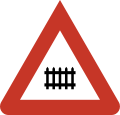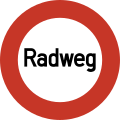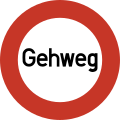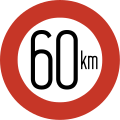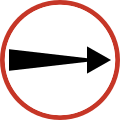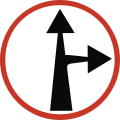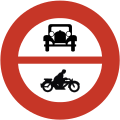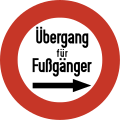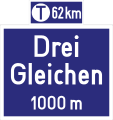Illustration of the traffic signs in the West German occupation zones and the Federal Republic of Germany from 1945 to 1953
The picture table of the traffic signs in the West German occupation zones and the Federal Republic of Germany from 1945 to 1953 shows the traffic signs in occupied West Germany until 1953, when the first significant amendment to the Road Traffic Act (StVO) was enacted in the Federal Republic of Germany . In addition to the traffic signs of the StVO, the traffic-related sign arrangements in the traffic gazette and in the railway building and operating regulations (BO) are discussed here. On the basis of the decree on traffic signs and facilities on Reichsautobahn of April 15, 1938, confirmed as federal law by the First General Administrative Regulation for the Order Management of Federal Highways of July 3, 1951, the motorway traffic signs are also dealt with here.
Since the occupying powers in the western zones mistrusted the German police authorities, their country-specific police rights to dispose of penalties, which were often exhausted in minor cases, were revoked in the British and American occupation zones due to considerations on the separation of powers. Only in the French zone did the police retain their special rights. In 1948, the German authorities made clear their displeasure with the removal of the police's rights to dispose of punishments. In the meantime, the local courts and lawyers were overloaded with the minor cases previously regulated by the police, as the number of violations of road traffic regulations was constantly increasing due to the steadily growing motorized traffic. The sometimes lax handling of German regulations by the occupying forces in particular offered potential for conflict. In the first post-war years, the legal side also asked how a road user should behave in view of the lack of road signs that were often destroyed during the war and what conclusions the judiciary would follow from this deficiency. In the years of shortages and starvation winters after the war, the theft of wooden posts, which were often used to fasten traffic signs, became a regional problem.
In principle, the Road Traffic Regulations from 1937 with their amendments remained valid until January 28, 1944, even after the end of the war, but a number of war-related and National Socialist-motivated sections were eliminated. With the Control Council Act No. 2 passed on October 10, 1945 , the Allied Control Council proclaimed the ban on the National Socialist German Workers' Party and its affiliated organizations. The ban also prohibited the use of the swastika . At the latest, the use of the 1943 traffic sign Fig. 34a call point of the NSKK-Verkehrshilfsdienst was legally prohibited. The Four Powers themselves put up some traffic signs that were not included in the StVO and were mainly used for orientation by the occupation troops and authorities. From September 7, 1949, the Road Traffic Regulations (StVO) continued to apply as federal law.
Shortly after the Federal Republic of Germany was founded in 1949, a disproportionate increase in traffic accidents was registered compared to the significantly increasing volume of traffic. According to the Federal Statistical Office (StatBA), the number of traffic accidents in the second quarter of 1951 alone was 80,509. That was 35 percent more than in 1950 and roughly twice as many as in 1937. Around 90 percent of the accidents were due to human error or fault. In the short period from April 1 to June 30, 1951, around 1900 people died in traffic and around 54,000 were injured. All efforts to get this dramatic development under control had failed by then.
During the time of the military rule of West Germany, road signs of the occupying powers were also decreed regionally. In its administrative report from 1948, the city of Braunschweig stated that in addition to 116 German traffic signs, 17 English traffic signs had been set up.
62nd. Military Police Highway Patrol Company
At the end of 1948, a Military Police Highway Patrol was established in the US occupation zone , which existed until 1958. The units, equipped with American patrol cars, were in use on the entire highway network of the US zone. The tasks of these police officers included ensuring road safety, observing traffic rules and helping with law enforcement in rural areas. In addition, the Highway Patrol was well versed in traffic assistance and helped with traffic accidents. A German police officer often accompanied the operations, among other things to act as an interpreter and to implement German law.
Colours
The traffic signs were based on the color register 840 R, which was introduced in 1940 during the Second World War . Register 840 R remained valid until 1971 and was replaced by new RAL systems with the then new version of the StVO.
The following colors were specified in the 840 R color register for traffic signs. In brackets are today's color names that did not exist back then.
- Red: RAL 2002 (blood orange)
- Yellow: RAL 2007 (bright orange)
- Blue: RAL 5002 (ultramarine blue)
In 1937, no standard was set for black and white, but it was pointed out that the standard color for white is RAL 1 (RAL 9002 - gray-white) and for black RAL 5 (RAL 9005 - jet black). A white paint job was also specified for the posts of the traffic signs.
With the standardization of the enamel colors by the RAL from 1940, it was now possible to produce many of the traffic signs in a uniform color scheme. By 1951, the industry had already developed paints for reflective paintwork. Traffic signs that were illuminated by car headlights showed a retroreflective effect.
typography
The typographical basis was the standard sheet for DIN 1451, first published in 1932 . In February 1951 a new edition became valid. As a recommendation in the Reichsgesetzblatt in 1937 it was stipulated that the fonts contained there should have a minimum line width of 7 millimeters. The numbers appearing on the traffic signs should be the height of the capital letters. Large letters were not less than 50 millimeters high and small letters not less than 35 millimeters high. Exceptions to these regulations have been set out on separate sample sheets.
Since typographic characters in particular were often still created by sign painters at that time, there could be significant deviations in the typeface and the expression of individual letters.
I. Warning signs
(Pictures 1 to 10)
II. Mandatory and prohibitive signs
(Pictures 11 to 31)
III. Notice signs
(Pictures 32 to 52)
Signs for lanterns that don't burn all night
(Pictures 35 to 36)
Place-name sign
(Pictures 37 to 38)
Since the introduction of the StVO, which came into effect on January 1, 1938, the term “ customs border district ” could be used instead of the administrative district . There was no separate picture for this in the regulation.
Signpost for Reichsstraßen (from 1951: Bundesstraßen)
(Pictures 39 to 41)
With retroactive effect to May 24, 1949, the Reichsstraßen were renamed federal roads with the law on the property relations of the federal highways and other federal highways of long-distance traffic of March 2, 1951.
Signpost for other paved roads
Signpost for unpaved roads
Reichsstrasse license plate (from 1951: Bundesstrasse license plate)
Signs for ring roads or collecting roads for long-distance traffic
Pre-signpost
(Pictures 46 to 51)
Signs for major roads
IV. Sign for directing traffic in the event of road closures
(Pictures 53 to 58)
Signal discs on bogies for traffic control in case of half-sided closures
(Pictures 53 to 54)
Signpost for diversions
(Pictures 55 to 56)
Sign for diversion of traffic on Reichsstraßen (from 1951: Bundesstraßen)
(Pictures 57 to 58)
Unnumbered characters, but also valid from January 1, 1938
Additional boards
Fig. 21 with the additional sign "oncoming traffic" on the Stuttgart – Ulm motorway near Wiesensteig in 1950.
Not listed in the StVO, but signs published in the Reichsverkehrsblatt
The following signs were originally published in the Reichsverkehrsblatt 1939, but were not included in the road traffic regulations. The regulation from the Reichsgesetzblatt was not repealed until 2006.
Control facilities
The provisions of the provisional guidelines for the expansion of rural roads (RAL 1937) from December 1942 continued to apply in the Federal Republic in part. However, there were textual modifications, as confirmed in the specialist book Die Straße from 1951. The paint for the guiding stones consisted of a 0.20 meter high white head and a 0.12 meter high black line immediately below it. Overall, guide stones or delineators should be placed wherever no other clearly identifiable features were to be found. The 1.20 meter long guide pegs had a diameter of 15 centimeters and a white head 20 centimeters high and a twelve centimeter wide black ring underneath. They should protrude 0.70 meters above the ground level. At the beginning of the 1950s, the street numbering was no longer on the guide stones, but on specially hewn or cast concrete kilometer stones, with the wider side facing the traffic showing the number of kilometers and the narrow side facing the street the painted black numbering on a yellow background.
Marks for level crossings at rail height
These signs were not included in the road traffic regulations. Their arrangement and setup was regulated by the Deutsche Reichsbahn-Gesellschaft, which was placed under Reich sovereignty from 1937 onwards through the law to reorganize the relationships between the Reichsbank and the Deutsche Reichsbahn . The legal relationships between World War II and 1949 were more complicated. In the American zone , the Reichsbahndirectors Augsburg, Frankfurt am Main, Kassel, Munich, Regensburg and Stuttgart (for the railways in Württemberg-Baden ) were subordinated to the United States Zone management in Frankfurt am Main. The Reichsbahn directorates in Essen, Hamburg, Hanover, Cologne, Münster (Westphalia) and Wuppertal were combined in the Reichsbahn general directorate in the British zone . In accordance with the formation of the bizone , the main railroad administration for the American and British occupation areas was created in 1946 . In 1947 it moved its headquarters to Offenbach am Main and called itself the "Deutsche Reichsbahn im Vereinigte Wirtschaftsgebiet". After the founding of the Federal Republic of Germany , the name was changed to " Deutsche Bundesbahn ".
Warning crosses
Warning lights
A slowly flashing white light meant: The crossing is free for road traffic . A rapidly flashing red light meant: Stop! The crossing is closed to road traffic . Paragraphs 79 (1) and 82 of the Railway Building and Operating Regulations govern the use of the signal system. Both the arms of the warning cross and the white and red edges of the warning light panel were provided with round reflectors to make the signs even more recognizable for drivers in the dark. The warning lights were operated electrically or, if there was no power supply, with acetylene . From 1943, the warning light systems with two lights - white and red - and systems that were additionally provided with the illuminated sign "Two trains" became part of the railroad with the Eleventh Ordinance on Changes to the Railway Construction and Operating Regulations of February 4, 1943 Building and operating regulations of July 17, 1928. This regulation became legally effective on February 23, 1943.
Warning lights for crossings of the railway building and operating regulations
Older warning lights that had not yet been dismantled
Motorway signage
The pre-war motorway signs remained unchanged until the 1956 StVO amendment. With retroactive effect to May 24, 1949, the Reichsautobahnen were renamed Federal Motorways with the Act on the Property Relationship of Federal Motorways and Other Federal Highways of Long-Distance Traffic of March 2, 1951.
Boards in the median
Boards on the right edge of the road
Autohof -Ankündigungstafel
(1947)
Boards at motorway filling stations
Web links
literature
- Fritz Joedicke: Safety measures when blocking an entire lane on the autobahn through signs and novel lane markings . In: Straße und Tiefbau 2 (1948), p. 330.
- Gregor Maria Kirschbaum (Ed.): The road law. Continuation work in loose-leaf form. A complete collection of all important legal provisions from road traffic and road construction, with additions and explanations according to the latest legal developments. Kirschbaum, Bielefeld 1949.
- Erwin Flister: Contribution to the knowledge of reflective substances for traffic signals . In: Straße and Autobahn 8 (1950), pp. 24–27.
- Forschungsgesellschaft für das Straßenwesen (Ed.): Leaflet for signposting on roads and highways , 1951.
- Forschungsgesellschaft für das Straßenwesen (Ed.): Instructions for the uniform design and uniform arrangement of place-name signs, signposts and signposts on roads and highways , 1952.
Remarks
- ^ Daniell Bastian: West German police law under Allied occupation (1945–1955). Mohr Siebeck, Tübingen 2010, ISBN 978-3-16-150424-2 . Pp. 91-95.
- ^ J. Arndt: Legal consequences of war damage in traffic signs. In. New legal weekly. 1st year, issue 18, 1947/48, Biederstein, Munich, Berlin 1948. P. 684.
- ↑ Nuremberg 1945–1949. Post-war history sources. Part 2: The term of office of the 1st City Council June 1946 – June 1948. City Archives, Nuremberg, 1989. ISBN 3925002219 . P. 557.
- ^ Reichsgesetzblatt , year 1944, No. 56, date of issue: Berlin, February 4, 1944, p. 48.
- ↑ Ordinance amending the Ordinance on Conduct in Road Traffic. In: Reichsgesetzblatt , year 1943, No. 55, date of issue: Berlin, May 31, 1943, p. 334.
- ^ Robert Adamek, Friedrich Saake: The road costs and their financing . In: Research from the Roads 8, New Series, Kirschbaum, Bielefeld 1952, p. 27.
- ^ Administrative report of the city of Braunschweig 1948 , Office for Statistics and Elections, Braunschweig 1949, p. 34.
- ^ Reminder page of the 62nd Highway Patrol (MP) - Germany ( Memento from May 22, 2016 in the Internet Archive ).
- ↑ Johannes Denecke: Lackfarben 1932-1945. In: Johannes Denecke Camouflage paints of the German army 1914 to today , Bernard & Graefe, Bonn 1999, ISBN 3-7637-5990-5 . Pp. 104-106.
- ^ Road Traffic Technology 4, 1973 (17th year), pp. 138-139; here: p. 131.
- ^ Johann Peter Noth, Reimund Wieg: 20 years of quality mark traffic signs . In: Straßenverkehrstechnik 4, 1978 (22nd year), pp. 138-139; here: p. 138.
- ↑ a b Reichsgesetzblatt , year 1937, No. 56, date of issue: Berlin, November 16, 1937, p. 1195.
- ↑ Commercial legal protection and copyright. Verlag Chemie, Weinheim an der Bergstrasse 1958, p. 444.
- ↑ Otto Merz: Painting in the sheet metal processing industry . In: Surface treatment in sheet metal processing 2, Düsseldorf 1951, p. 57.
- ↑ Design and execution of traffic signs . In: Straße und Autobahn , Issue 4, 1980, p. 287.
- ↑ a b c d Reichsgesetzblatt , year 1937, No. 56, date of issue: Berlin, November 16, 1937, p. 1192.
- ↑ a b c d Reichsgesetzblatt , year 1937, No. 56, date of issue: Berlin, November 16, 1937, p. 1193.
- ^ Ordinance on behavior in road traffic (Road Traffic Regulations - StVO -) of November 13, 1937 . In: Reichsgesetzblatt , Part 1, year 1937, No. 56, Berlin, November 16, 1937, p. 1193.
- ↑ a b Act on the property relations of the federal motorways and other federal highways for long-distance traffic . In: Bundesgesetzblatt , year 1951, No. 11, date of issue: Bonn, March 6, 1951, p. 157.
- ^ Reichsverkehrsblatt B, No. 33 of July 29, 1939.
- ^ First law on the adjustment of federal law in the area of responsibility of the Federal Ministry for Transport, Building and Urban Development. From September 19, 2006. Article 27: Repeal of the regulation on the introduction of uniform stop signs for trams and motor vehicle lines. In: Bundesgesetzblatt I, No. 44, Bonn on September 30, 2006, pp. 2146–2153; here: p. 2148 and p. 2153.
- ^ Rudolf Kraus: The street. Guide for teaching in higher technical schools . Braun, Karlsruhe 1951, p. 52.
- ↑ Jürgen Zabel (Ed.): Railways in the Frankfurt RheinMain region . Hestra-Verlag, Darmstadt 2002, ISBN 978-3-7771-0304-4 , p. 29 .
- ↑ E. Behr: Securing path crossings at rail height . In: VDI-Zeitschrift , 34 Volume 82, (1939), p. 965 ff .; here: p. 970.
- ↑ Eleventh ordinance amending the railway building and operating regulations of February 4, 1943. In: Reichsgesetzblatt , No. 5, Part II, February 16, 1943, pp. 17-29.







